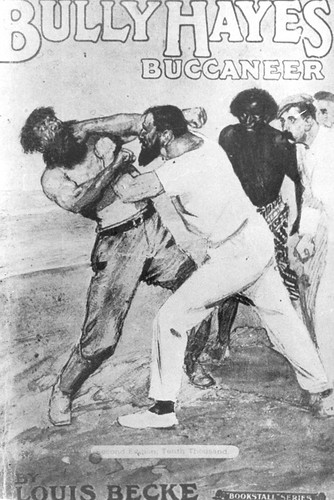Slaver captured by CHamorus
William “Bully” Hayes was a blackbirder (slave trader) and criminal who in the 19th century terrorized the inhabitants of Micronesia for many years. He was born in Cleveland, Ohio sometime around 1829 and died in the Marshall Islands in 1877. In the last years of the 19th century and early decades of the 20th century he became a legendary figure as an adventurer.
Although the British authorities of the HMS Rosario tried to capture Hayes in Kusaie (now Kosrae, Federated States of Micronesia) after the accusations made against him by the islanders and his own crew, the credit for the arrest of Hayes shall always be for CHamoru lieutenant and gobernadorcillo (little governor or mayor) of Hagåtña José Pérez Cruz, who captured Hayes in his undergarments, in a cove near Falcona Point in northeastern of Guam.
Hayes landed at Guam on 28 February 1875. He apparently planned to engage in commerce with a Captain Willney and bought a small schooner – the Joaquina Ana – from Francisco Portusach who would later become the disputed acting governor of Guam after American Captain Henry Glass seized Guam from the Spanish in 1898.
Hayes renamed the ship Arabia and after satisfying official requirements, departed Apra Harbor on 8 April bound for Pohnpei but secretly carrying nine Spanish political deportees sentenced to exile on Guam and six CHamorus wishing to emigrate illegally. These people had apparently paid whatever price Hayes demanded of them.
Eventually alerted to the scheme and the Arabia having been sighted off Falcona Point, CHamoru Lieutenant José Pérez Cruz with 20 men of the local militia walked overland to Falcona. Seeing the Arabia silhouetted against the horizon, Pérez and his men waited through the night and finally saw Hayes approach the shore early the next morning in a boat in his underwear.
Intending from the start to get rid of his illegal passengers, Hayes had spent the night pretending the wind was too weak to sail and attempted to get them to go to the shore to swim. Prompted by their reluctance, Hayes took off his clothes to convince them he was serious about taking a swim and was promptly seized by Lt. Pérez and his men.
Seeing what was happening on shore, the passengers forced the pilot to pull anchor and sail on to Palau where the CHamorus may have gotten off. The Arabia then sailed on to Singapore where the deportees found their way home to Spain. Hayes was imprisoned in Hagåtña until 10 June when he was sent to Manila, tried and imprisoned for about nine months.
After spending some time in San Francisco, Hayes in April 1877 returned to Micronesia on board the yacht Lotus. While sailing from Kosrae to Jaluit in the Marshall Islands, a crew member struck him with an iron fitting and killed him. Reportedly, he left a widow and twin daughters in Samoa, and most probably an undetermined number of illegitimate descendants in different islands of the Pacific.
In 1983, Hollywood star Tommy Lee Jones portrayed William Hayes in the movie Nate and Hayes. In 1986, the Federated States of Micronesia issued a number of stamps based on scenes of his tumultuous life.
By Carlos Madrid and Nicholas J. Goetzfridt, PhD
For further reading
Cleveland Midweek Review Pictorial. “Cleveland Born Pirate.” 20 November 1932.
Clune, Frank. Captain Bully Hayes: Blackbirder and Bigamist. Sydney: Angus & Robertson, 1970.
Earnshaw, John. “Hayes, William Henry (Bully) (1829-1877).” In Australian Dictionary of Biography. Vol. 4. Melbourne: Melbourne University Press, 1972.
Lubbock, Basil. Bully Hayes, South Sea Pirate. Boston: Charles E. Lauriat Company, 1931.
Madrid, Carlos. Beyond Distances: Governance, Politics and Deportation in the Mariana Islands from 1870 to 1877. Saipan: Northern Mariana Islands Council for Humanities, 2006.
Saunders, AT. Bully Hayes. Perth: “The Sunday Times” Publishing Co. Ltd., 1932.
Trood, Thomas. Island Reminiscences. Sydney: McCarron, Stewart & Co., 1912.



